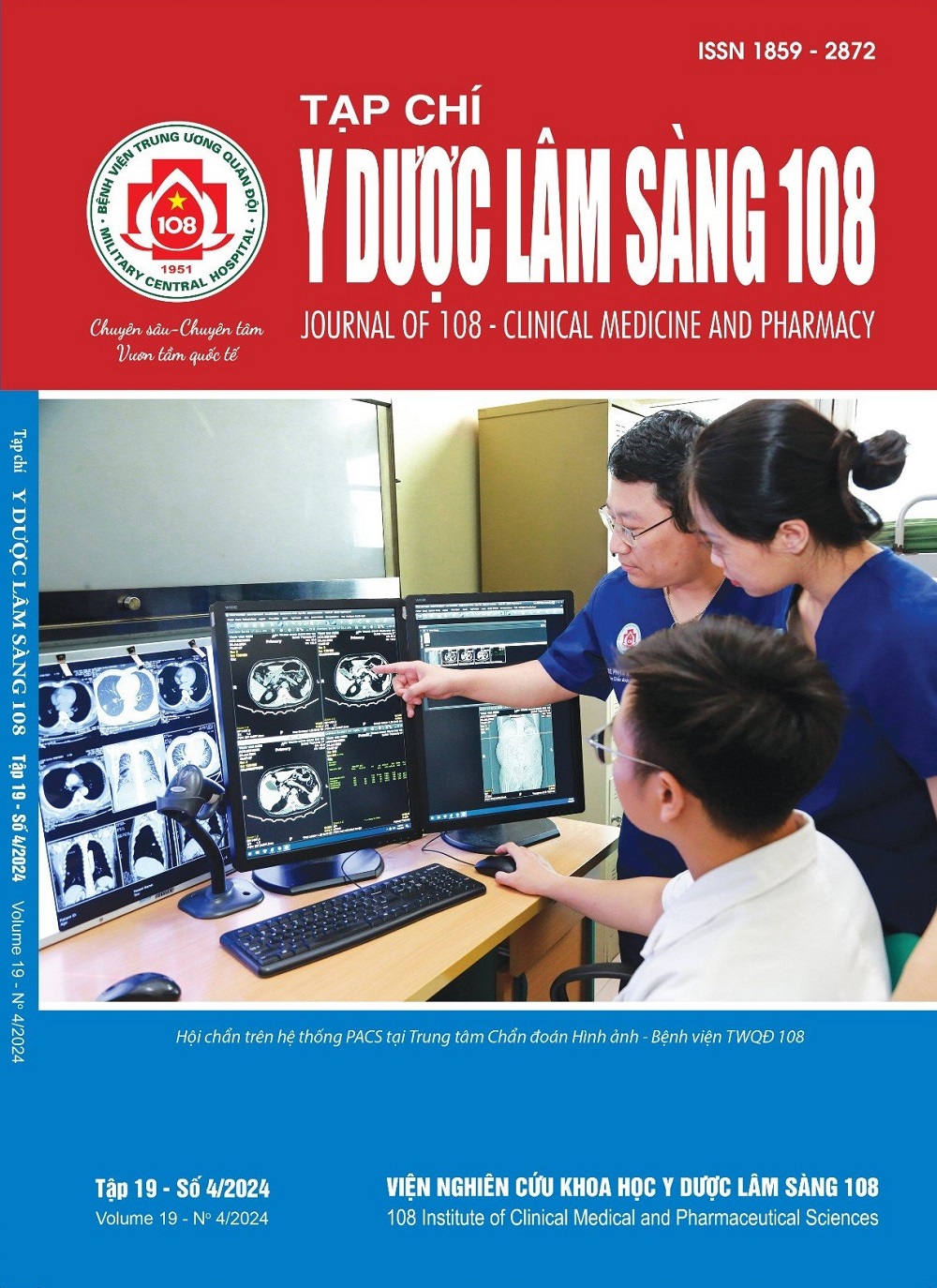Assess the value of urinary L-FABP concentrations in response to rigorous-intensity exercise
Main Article Content
Keywords
Abstract
Objective: To assess the value of urinary L-FABP concentrations in response to rigorous-intensity exercise and the potential correlation with varying exercise intensities. Subject and method: We conducted a cross-sectional, prospective descriptive study at unit X, laboratory was performed at 108 Military Central Hospital from January 2022 to December 2022, involving healthy soldiers ≥ 18 years old, excluding those with chronic kidney disease. The variables of interest included clinical measurements, serum urea and creatinine concentrations, and urinary L-FABP concentrations collected pre and post-exercise. Subsequently, we assessed variations in urinary L-FABP concentrations before and after exercise, in comparison to changes in serum urea and creatinine concentrations. This analysis aims to elucidate correlations of aforementioned variables between pre- and post-exercise states, and in response to varying intensities of physical training. Result: A total of 300 subjects were selected for the study. Urinary L-FABP concentration after exercise increased statistically significantly higher than before exercise (p<0.001). There was no correlation between post-exercise urinary L-FABP concentrations and post-exercise blood urea (p = 0.76) and blood creatinine (p = 0.163) concentrations. There was a positive correlation between urinary L-FABP concentration and exercise intensity (r = 0.421, p<0.001). Conclusion: An increase in urinary L-FABP concentrations in response to vigorous intensity exercise was shown in this study. There was also a positive correlation between the increase in post-exercise urine L-FABP concentration and exercise intensity.
Article Details
References
2. Đặng Quốc Bảo và Lê Văn Nghị (2015) Sinh lý lao động quân sự. Quân đội nhân dân, tập 1. 138
3. Piercy KL, Troiano RP, Ballard RM, Carlson SA, Fulton JE, Galuska DA, George SM, Olson RD (2018) The Physical Activity Guidelines for Americans. JAMA 320(19): 2020-2028.
4. World Health Organization (2012) Global physical activity questionnaire (GPAQ) analysis guide. Geneva: World Health Organization: 1-22
5. Hewing B, Schattke S, Spethmann S, Sanad W, Schroeckh S, Schimke I, Halleck F, Peters H, Brechtel L, Lock J, Baumann G, Dreger H, Borges AC, Knebel F (2015) Cardiac and renal function in a large cohort of amateur marathon runners. Cardiovasc Ultrasound 13: 13.
6. Otani H, Kaya M, Tsujita J (2013) Effect of the volume of fluid ingested on urine concentrating ability during prolonged heavy exercise in a hot environment. J Sports Sci Med 12(1): 197-204.
7. Kamijo-Ikemori A, Kimura K (2022) Clinical utility of tubular markers in kidney disease: A narrative review. Journal of Laboratory and Precision Medicine 7:27.
8. Kosaki K, Kamijo-Ikemori A, Sugaya T, Kumamoto S, Tanahashi K, Kumagai H, Kimura K, Shibagaki Y, Maeda S (2020) Incremental short maximal exercise increases urinary liver-type fatty acid-binding protein in adults without CKD. Scand J Med Sci Sports 30(4): 709-715.
9. Kawakami S, Yasuno T, Kawakami S, Ito A, Fujimi K, Matsuda T, Nakashima S, Masutani K, Uehara Y, Higaki Y, Michishita R (2020) The moderate-intensity continuous exercise maintains renal blood flow and does not impair the renal function. Physiol Rep 10(15): 15420.
10. Kosaki K, Kamijo-Ikemori A, Sugaya T, Tanahashi K, Kumagai H, Sawano Y, Akazawa N, Ra SG, Kimura K, Shibagaki Y, Maeda S (2017) Relationship between exercise capacity and urinary liver-type fatty acid-binding protein in middle-aged and older individuals. Clin Exp Nephrol 21(5): 810-817.
11. Bộ Quốc Phòng (2023) Quy định tiêu chuẩn sức khỏe, khám sức khỏe cho các đối tượng thuộc phạm vi quản lý của Bộ Quốc Phòng, truy cập ngày 14-1-2024, tại web https://chinhphu.vn/?pageid=27160&docid =209184.
12. Piercy KL, Troiano RP, Ballard RM, Carlson SA, Fulton JE, Galuska DA, George SM, Olson RD (2018) The Physical Activity Guidelines for Americans. JAMA 320(19): 2020-2028.
13. Your lungs and exercise. Breathe (Sheff). 2016 12(1):97-100. doi: 10.1183/20734735.ELF121.
14. Goldberg TH, Finkelstein MS (1987) Difficulties in estimating glomerular filtration rate in the elderly. Arch Intern Med 147(8): 1430-1433.
15. Ullah M, Khan A, Jamil M, Iqbal Butt MZ, Ullah I, Zubair M, Saheem S, & Nasir H (2023) Impact of vigorous exercise on blood serum creatinine concentration among. THE THERAPIST (Journal of Therapies &Amp; Rehabilitation Sciences) 4(02): 33–36.
16. Poortmans JR (1984) Exercise and renal function. Sports Med 1(2): 125-53.
17. Khwaja A (2012) KDIGO clinical practice guidelines for acute kidney injury. Nephron Clin Pract 120(4): 179-84.
18. Noiri E, Doi K, Negishi K, Tanaka T, Hamasaki Y, Fujita T, Portilla D, Sugaya T (2009) Urinary fatty acid-binding protein 1: An early predictive biomarker of kidney injury. American journal of physiology-Renal physiology 296(4): 669-679.
19. Nakamura T, Sugaya T, Koide H (2009) Urinary liver-type Fatty Acid-Binding Protein in septic shock: Effect of polymyxin B-immobilized fiber hemoperfusion. SHOCK 31(5): 454-459.
20. Hiraki K, Kamijo-Ikemori A, Yasuda T, Hotta C, Izawa KP, Watanabe S, Sugaya T, Kimura K (2013) Moderate-intensity single exercise session does not induce renal damage. J Clin Lab Anal 27(3): 177-180.
 ISSN: 1859 - 2872
ISSN: 1859 - 2872
